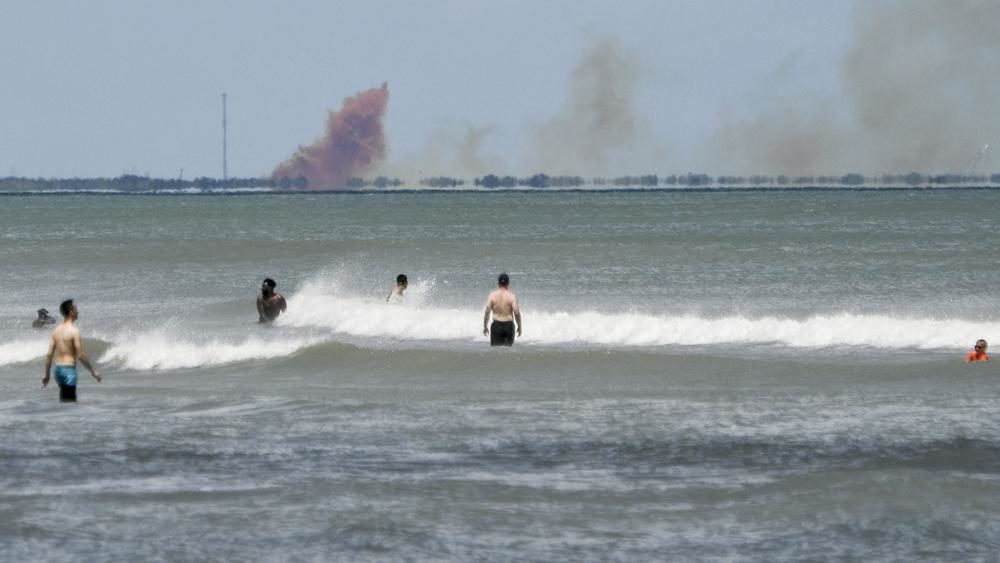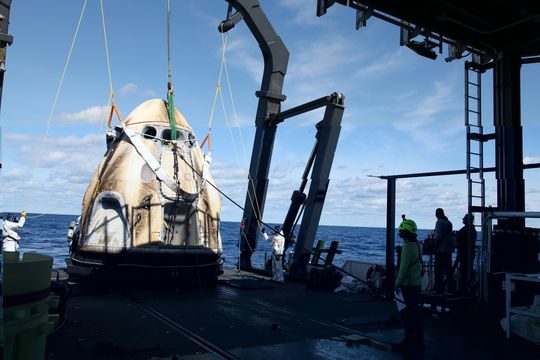
Officials including Vice President Mike Pence hailed last month's successful first test flight of the company's Crew Dragon capsule as the dawn of a new era of commercial spaceflight.
A pair of astronaut test pilots were on track to fly a Crew Dragon to the International Space Station as soon as July.
Not so fast.
The same capsule retrieved from a March 8 splashdown off the Florida coast was believed to have been destroyed Saturday during preparations for another test flight in June.
Acrid smoke that billowed from Cape Canaveral Air Force Station, visible for miles along the Space Coast, clouded the outlook for SpaceX's crew program and NASA's optimism that reliance on Russia for rides to the station would end soon.
The space agency already was scrambling to come up with options for maintaining U.S. access to the station as it runs out of seats on Russia's Soyuz spacecraft early next year.
With Boeing not planning to fly a test crew before November, and SpaceX's timeline now less clear, those options are growing more important.
The Crew Dragon incident may also delay a planned April 30 launch to the station of a cargo-flying Dragon, which shares some common components.
Details about what happened Saturday on a test stand at one of SpaceX's two rocket landing pads are sparse.
The company confirmed that after a series of successful tests of a Crew Dragon capsule, something went awry on the final test.
"Our teams are investigating and working closely with our NASA partners," SpaceX said in a statement.
Teams were test-firing thrusters and engines that are used both to maneuver the capsule in space, and as a critical abort system that would allow astronauts to escape from a failing rocket on its pad or during the ride to orbit.
The Crew Dragon that flew in space recently was being readied for launch again as soon as June for a test of that emergency abort system.
The used Crew Dragon, with no one on board, was to fire powerful SuperDraco engines to push the spacecraft away from a Falcon 9 rocket about a minute after its launch from Kennedy Space Center.
The capsule's apparent explosion on the ground offers a stark reminder of the risks astronauts face, and did not inspire confidence that the Crew Dragon is ready to fly crews.
At the same time, only hardware was lost Saturday, not lives. SpaceX and NASA emphasized that test failures help engineers design safer spacecraft and flag problems before people fly.
"Ensuring that our systems meet rigorous safety standards and detecting anomalies like this prior to flight are the main reasons why we test," SpaceX said.
"This is why we test," echoed NASA Administrator Jim Bridenstine. "We will learn, make the necessary adjustments and safely move forward with our Commercial Crew Program."
Last month, with the Crew Dragon in the midst of a smooth first demonstration flight, independent safety advisers urged vigilance, saying the days ahead were "a time for both optimism and caution, not a time for haste."
SpaceX recovered fairly quickly from Falcon 9 failures in 2015 and 2016, the latter involving a spectacular launch pad explosion that also sent a plume of smoke above the Cape.
The company has been working to redesign pressurized helium tanks at the root of that rocket mishap, and also in the Dragon's propulsion system, though there's no indication that system was at fault Saturday.
Boeing's schedule already reflects delays from a test stand failure last year of the CST-100 Starliner capsule's abort engines. Another important test of the Starliner's abort system, called a pad abort, is targeted for this summer in New Mexico.
It was not immediately clear how the Crew Dragon setback might affect SpaceX's Commercial Crew schedule.

Or, is it possible that the in-flight abort test was desirable but not absolutely necessary?
Boeing did not include one in its program for earning NASA certification of the Starliner's safety. SpaceX already has performed a pad abort test like the one Boeing is working towards.
But following an apparently catastrophic failure, SpaceX's in-flight abort test may be seen as even more important, if only politically.
NASA and its Commercial Crew partners have insisted they will not bow to schedule pressure and fly crews before the new capsules are ready.
But the space agency has already shifted its test program approach with an eye to ensuring it can continue to staff the $100 billion space station even if Boeing and SpaceX need more time.
Though Boeing's Starliner has yet to fly, NASA recently exercised a contract option that would turn its first test flight with a three-person crew, now targeted for November, into a long-duration mission.
NASA also plans to buy two more seats on Russia's Soyuz spacecraft, making another ride available in the spring of 2020.
"NASA is committed to launching U.S. astronauts aboard domestic spacecraft," the agency said about that deal. "Obtaining this Soyuz transportation provides flexibility and back-up capability without adding unnecessary schedule pressure to our U.S. commercial crew providers."
After Boeing and SpaceX each have flown test flights with astronauts, NASA will certify their safety to fly operational missions with four-person crews - one more person than can fit in a Soyuz.
The extra crew member was expected to double the amount of science research that station crews could accomplish.
But if the U.S. capsules are not ready to fly crews as the Soyuz seats run out, NASA might end up with fewer crew members achieving less science on the station for a period of time.
NASA had been expected to update SpaceX's test flight schedule any day now. After Saturday's events, that update will likely need further revision.



Comment: Neither Boeing or SpaceX are inspiring confidence in the US' ability to command the skies: